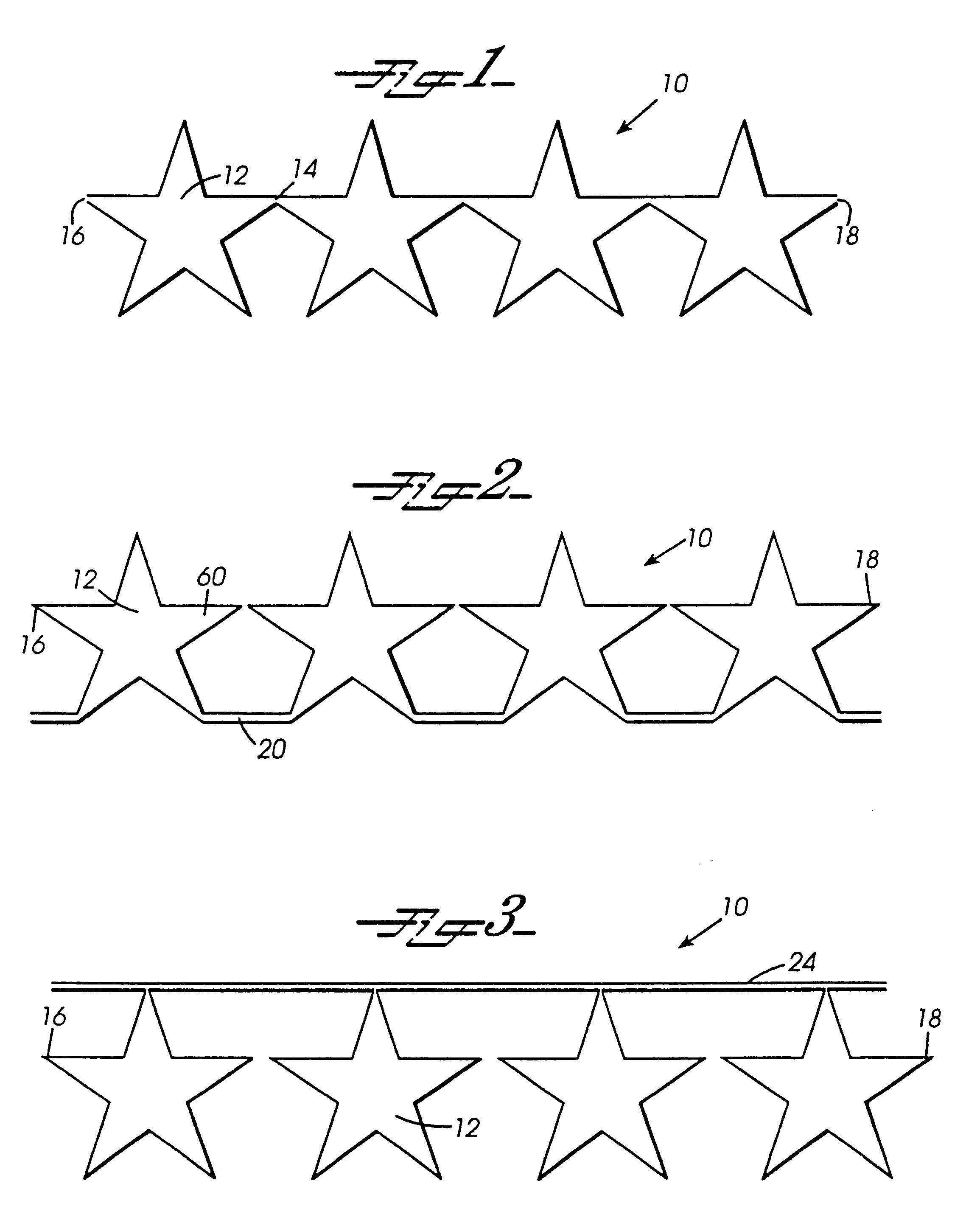According to its preferred aspects and briefly stated, the present invention is a balloon display
system. The system includes balloons and means for supporting the balloons in an arrangement that is either pleasing or informative or both. The balloons may be common, individual balloons, but are preferably "film balloon systems." The supporting means is a matrix either made by expanding a sheet of material into which an array of slits has been
cut or by using a multidimensional film balloon system. All three of these terms will be defined herein, however, a balloon system is a single balloon that appears to be a plurality of balloons, called "balloonlets" herein, but which are inflated and deflated all at one time, and which, when inflated, are configured with respect to each other to effect a balloon display. The expandable matrix is a sheet of single or multiple
layers that is strong, flexible, somewhat resilient material into which a pattern of overlapping cuts has been made so that, when expanded, will form a patterns of holes for holding balloons or balloonlets. The multidimensional balloon systems is essentially a single, three dimensional balloon composed of balloonlets, openings, and passages that add strength and function to the system. The system can thus serve not only as a balloon display, possibly free-standing, or as a grid for supporting balloons itself. The result of the combination of balloon systems and matrixes made according to the present invention is a new tool for those who wish to create unique and dynamic balloon structures and displays quickly, easily and inexpensively.
The balloon system is constructed primarily by the repeated application of the same die, a die that is formed to interconnect the shape so formed so that each balloonlet created by the die is automatically in fluid communication with the previous one formed. Additionally, certain features are incorporated into the interconnecting conduits so that the balloonlets maintain their alignment when inflated. Also, variations in the primary process are taught herein to allow variations in the chain of balloonlets. Because the balloon system is actually all one balloon, although it may appear to be dozens, perhaps thousands, of balloons, it has the
advantage of being more easily inflated than individual balloons that would otherwise be needed to create the same display. To minimize the risk of puncture in a balloon system that is actually one large balloon, high quality, more puncture-resistant balloon films are preferred to
latex rubber.
The grid structure that is used with the present balloon display is created under a third paradigm, as opposed to the first two described in the Background of the Invention. This paradigm begins with a structure similar to the formation of
expanded metal grids for walkways, but by using certain techniques outlined herein, such as hooked and forked cuts and by shaping the material in certain ways, the result is a high degree of design flexibility. The present invention goes beyond standard overlapping cut expandable grids to produce a variety of expandable matrixes in flat shapes and patterns and in three dimensional forms not feasible under the preexisting state of the art. These cuts are generally made with an efficient die cut process as in the first paradigm, and yet, the thin character of the cuts minimizes
waste material. Furthermore, none of the more costly assembling of elements required in the second paradigm is necessary. Because of the expandability of products manufactured under the third paradigm, the finished display may easily be five or more times the size of a manufactured framework. This efficiency of production and compactness along with related lighter weight are important advantages for uniting and connecting balloons into balloon displays.
Also, the cut is preferably made with rounded ends to avoid tearing the material. Many materials useful for balloon displays because they are light-weight, flexible, somewhat resilient and inexpensive are quite strong under tension, but rip easily once a tear has begun. Simple slits have the nature of a tear and, in such material, could render the sheets useless for the normal stresses of an overlapping cut expandable framework. By making careful cuts with smoothly rounded ends, the cut could take on the nature of an outer edge of the sheet rather than a tear. Even materials which
resist ripping after a tear will be strengthened by the change to carefully made rounded ends to the cuts.
The simplest form of balloon system is a row of balloonlets. However, by the use more complex dies, as would be best effected with a computer controlled
laser sealing process, by use of more than two
layers, and by use of a predetermined pattern of
adhesive treatment, extraordinary structures can be created in three dimensions. These structures are single balloons, and when inflated, form passages, balloonlets, and openings for other balloons, balloon systems, and possibly other objects. The
advantage of such a multidimensional balloon system is that complex three dimensional balloon shapes can be made of a single high-quality balloon for repeated use.
 Login to View More
Login to View More  Login to View More
Login to View More 


